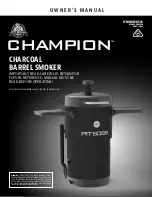
9
A. To try the speakers on different walls, set your equip-
ment in the middle of the room so the speaker cables
can reach each position.
B. When you change the placement of the speakers, listen
to several different pieces of music before judging the
results.
C. If you set the speakers on a wood floor, place a coin
under each stand spike or use 3/8-16 thread carriage
bolts in place of the spikes to prevent damage to the
floor. Carriage bolts have rounded heads that will not
put holes in the floor.
D. Keep the spikes or carriage bolts on the bottom of the
stands as short as possible while still accomplishing the
proper vertical angle for your listening height and dis-
tance.
H
ELPFUL
S
ET-
U
P
H
INTS
E. When you have discovered the optimum speaker posi-
tioning in your room, mark it with tape so you can move
the speakers to vacuum without loosing your placement
reference.
F. If the bass is ill-defined in your room regardless of
where you place the speakers, check your windows for
loose panes of glass. Loose glass will vibrate and can
seriously impair the low frequency detail of the system.
G. Keep notes on the sound different placements you try. It
is easy to get mixed-up and forget which placement
sounded the best.
H. Don’t over-analyze sound of each placement. When the
sound is right, it will be obvious.
A
MPLIFIER
R
EQUIREMENTS
The Model 2Ce Signature II is designed for use with
amplifiers rated at 40 to 160 watts per channel into 8 ohms.
Amplifiers in this power range will provide ample power
for realistic listening levels in most situations. Amplifiers
with less than 40 watts may not be able to drive the Model
2Ce Signature to realistic listening levels without stress,
while amplifiers with more than 160 watts must be used
with caution due to the increased potential for speaker dam-
age if they are misused or an accident occurs.
The Model 2Ce Signature II’s are very revealing speak-
ers and are easily capable of showing subtle sonic differ-
ences between amplifiers. They will perform well with a
transistor, or hybrid amplifier, allowing each design to real-
ize its full potential. The amplifier can be a quality re-
ceiver, integrated amplifier or separate amplifier. The sta-
ble impedance of the Model 2Ce Signature reduces load
induced amplifier problems, expanding the possible ampli-
fier choices.
The stability of the amplifier to be used should be con-
sidered, as it will affect the current capability and therefore,
the dynamics and realism of the music. A stable transistor
amplifier will be able to deliver twice the wattage into 4
ohm load as is does into an 8 ohm load. Amplifiers with
this ability should perform well with the Model 2Ce Signa-
ture.
C
OMPONENTS
To maximize the performance of your system, you
should properly set-up your components according to the
manufacture’s instructions. Each component should be
placed on a piece of furniture or in a stand that is stable and
not prone to vibration or rocking. An isolation base or iso-
lation feet may improve the sound of some electronics.
Allow sufficient air space around the electronics for
needed air circulation. Excessive heat can both shorten the
C
ABLES
the life of electrical components and impair their perform-
ance.
Preamplifiers and CD players should be left on all the
time. Amplifiers should be turned off when the system is
not being used. Once broken in, modern amplifiers sound
good after only 20 minutes of warm-up. Leaving the ampli-
fier on all of the time exposes the speakers to possible dam-
age from power line anomalies or electrical component
failure while the system is unattended
Our evaluations and tests have convinced us the inter-
connect and speaker cables should be considered an inte-
gral part of the music system. Each brand and model of
cable has its own sonic characteristic and contributes to the
overall presentation of the music as much as any active
component. The Model 2Ce Signature easily passes the
amount of information required to hear these differences
between cables.
The testing also confirmed the importance of keeping
speaker cables as short as possible. In repeated trials, short
runs of moderate to inexpensive speaker cable consistently
out performed long runs of the same cable as well as much
more expensive cable. If your speakers must be placed a
long distance from your electronics, we recommend that
the amplifier be placed between the speakers and long in-
terconnect cables be used between the amplifier and power
amplifier so that short speaker cables can still be used. Cur-
rently, long interconnect cables seem to compromise the
sound of a stereo system less than long speaker cables.
When you evaluate different interconnect or speaker
cables, remember that the dielectric in most quality cables
takes many hours to fully form. These cables will not reach
their full potential until they have been used for several
weeks.
A
SSOCIATED
E
QUIPMENT






























